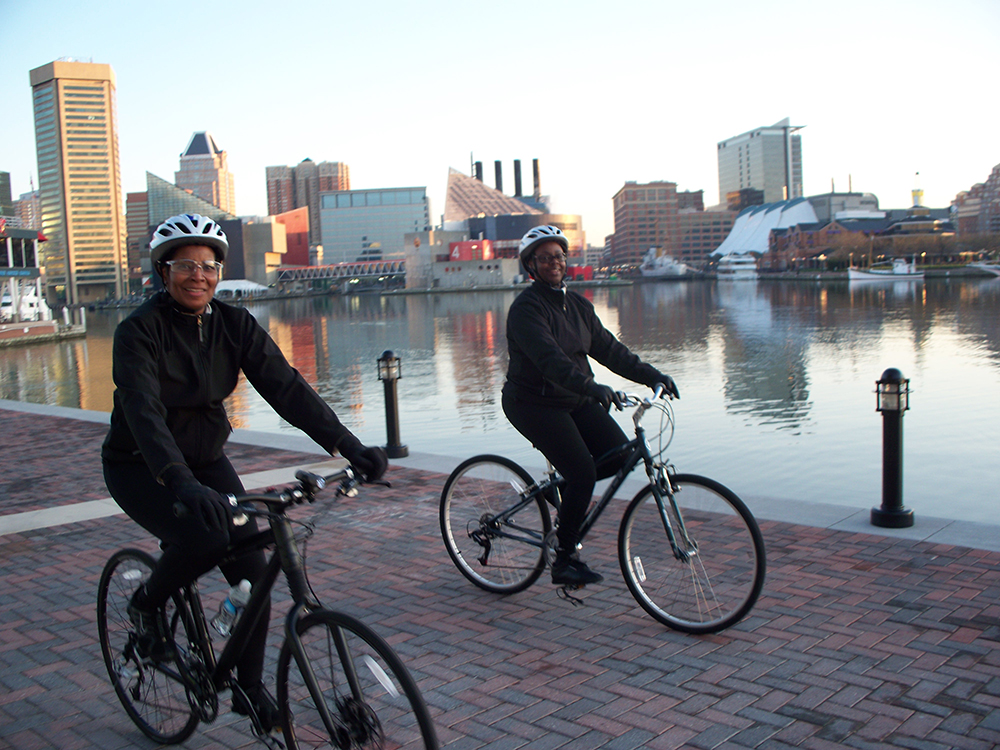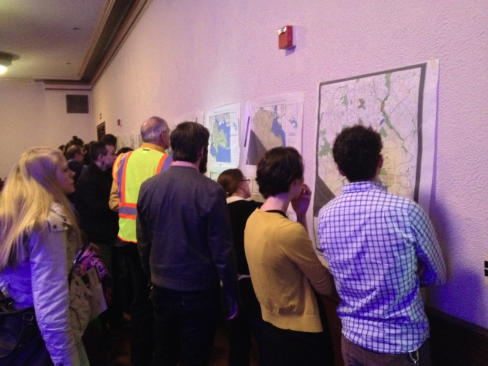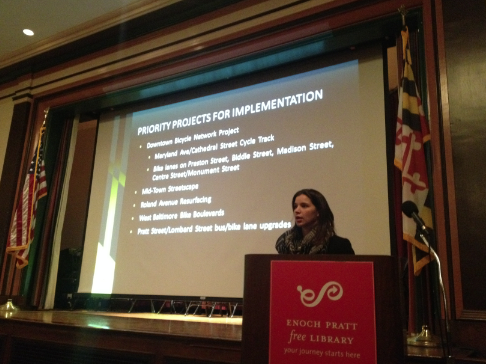
Nearly 100 bicyclists turned out last week at the downtown Enoch Pratt Free Library for a preview of the city’s new bike master plan, unveiled online Tuesday afternoon by the Baltimore City Department of Transportation. By 2028, the stated objective is to create a network of 253 miles of bike lanes, trails, protected tracks, and facilities enabling as much as 8 percent of commuters to make bicycling their primary mode of transportation.
Currently, Baltimore has 162 overall miles of bike lanes, with 119 miles installed since the adoption of the 2006 bicycle master plan. The new 94-page draft also touts the city’s growing bicycle culture, highlighting regular group rides such as the Baltimore Bike Party; annual bike tours, such as the Tour du Port and Tour dem Parks, Hon; and annual events, including the American Visionary Art Museum’s Kinetic Sculpture Race, Patterson Park’s summer Bike Jam; and Bike to Work Day.
Caitlin Doolin, now the city’s full-time bike and pedestrian coordinator, said in her presentation that while Baltimore has fallen behind other cities in bicycle infrastructure and viability—it remains, potentially, an ideal locale for bike commuting. She noted that Baltimore has a dense downtown workplace environment and a population that is young (50 percent under 35 years old) and relatively car-free (34 percent of city resident don’t own an automobile).
Highlights of the plan include:
—The addition of roughly 90 miles of new city bike lanes and trails by 2028
—A Maryland Avenue protected cycle track from 29th Street to Pratt Street, completed this year
—$7 million in new streetscaping in Midtown, including a protected two-way cycle track on Mount Royal Avenue
—The creation of West Baltimore “bike boulevards” (roads that emphasis safe bicycle access) on Hollins, W. Lexington, W. Baltimore, Carrollton, and N. Smallwood streets
—Bus/bike lane improvements on Pratt and Lombard streets
—The development of a B’More Bicycle-Friendly Business Program
—Implementation of the Charm City Bikeshare by 2016
Other goals include additional bike parking and racks, promoting bicycle safety at schools, bicycling access to the Inner Harbor’s Waterfront Promenade, and mountain bike routes and pump tracks in city parks.
While bicyclists generally applauded the DOT’s goals, a number of people in attendance expressed frustrated that the new plan—the first update since 2006—hadn’t been posted online prior to the public meeting. According to city officials at the library meeting, where poster-sized maps of the proposed new bike lanes and trails were pictured, the plan would be online by Feb. 2 with a public comment period following for 14 days.

That deadline was one of several missed in recent years. Almost exactly a year ago, a DOT official said the Maryland Avenue cycle track would be completed by this past fall.
The city has also been forced to push back plans to launch the proposed Charm City Bikeshare program several times even though funding for the project has been in place for a couple of years. Doolin said after last week’s public meeting that new requests for potential bikeshare vendors will be going out this spring and, according to the new plan, the goal is to have the first phase of Charm City Bikeshare implemented by 2016. “There is still two years in seed money for bikeshare, $1.1 million for the city, [dedicated] to start up costs,” Doolin said.
The city did, however, recently cut yearly fees for companies wishing to add a bicycle rack on the sidewalk in front of their business.
“I think the stuff on the posters [the planned new bikes lanes and trails] looks great, but you can’t ride on pretty lines on the wall,” said Greg Hinchliffe of Bikemore, the city’s nonprofit bicycling advocacy organization. “The planning looks great; the bottom line is implementation.”
*An earlier version of this story said the goal of new Baltimore Bicycle Master Plan was to build 180 miles of new bike lanes and trails. The goal is to create a network of 253 total miles of bike lanes and trails by 2028.

